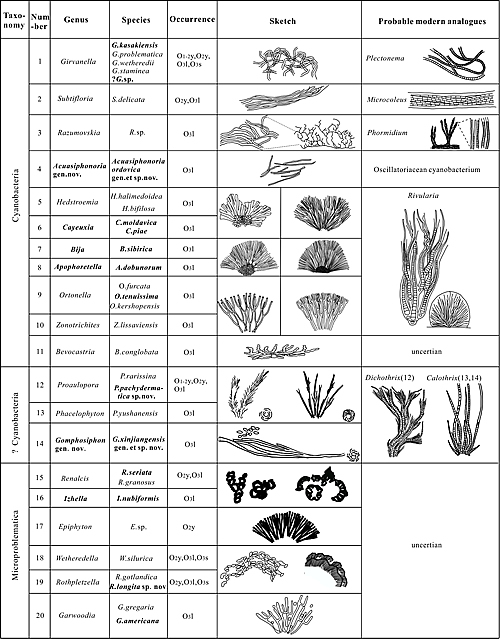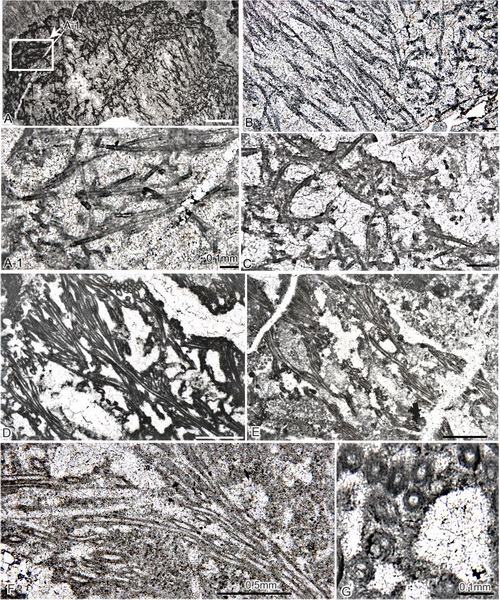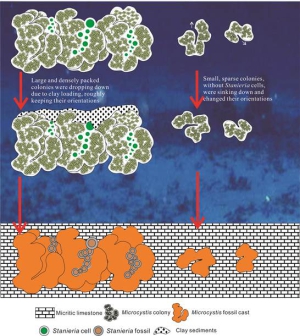The Most Diverse Ordovician Calcified Cyanobacteria Flora Was Found in the Tarim Basin, Northwest ChinaUpdate time:05 12, 2016
Cyanobacterial calcification is related to photosynthetic inorganic carbon uptake, raising the pH adjacent to cyanobacterial cells and promoting CaCO3 precipitation situated in or on the mucilaginous sheath of some cyanobacteria. Calcified sheaths can be preserved as microfossils and widely occur in the marine carbonate strata of the Neoproterozoic, Palaeozoic and Mesozoic. Recently, however, cyanobacterial calcification has been found to be widespread in freshwater lakes and streams in limestone areas, but is virtually unknown in marine environments. This could reflect temporal changes in seawater chemistry and in atmospheric carbon dioxide. However, tracking the geological history of calcified cyanobacteria is hindered by the morphological simplicity of their fossils. The lack of distinctive criteria makes it difficult to confidently recognize calcified cyanobacteria and creates uncertainties in the taxonomy of these and superficially similar calcified microbes. Calcified cyanobacteria and associated microfossils described from the Ordovician have generally been regarded as sparse, to the point that the Middle and Late Ordovician was at one time considered as an episode of reduced cyanobacterial calcification. Postdoctoral fellow Liu Lijing and her supervisor Associate Prof. Wu Yasheng from the CAS Key Lab of Petroleum Resource Research, IGGCAS and coworkers carried out an extensive study of calcified cyanobacterial fossils in 8500 thin sections from drill core samples from 64 wells in the Tazhong, Tabei, Bachu and Tadong areas of the Tarim Basi,. The thin sections, which span most of the Ordovician were investigated using transmitted light microscopy, many examples of these fossils in the thin sections were measured, photographed and identified. Thirty-two species amongst 20 genera, including two new genera and two new species were identified; most of them are from the Middle and Late Ordovician (Figures 1 and 2). The authors describe and compare these taxa to previous studies and also widely compare them with modern marine cyanobacteira. Girvanella, Subtifloria, Razumovskia, Acuasiphonoria gen. nov., Hedstroemia, Cayeuxia, Bija, Apophoretella, Ortonella, Zonotrichites and Bevocastria are attributed as being calcified cyanobacteria, and are compared with some of modern oscillatoriaceasns and rivulariaceans. Proaulopora, Phacelophyton and Gomphosiphon gen. nov. are classified as probable calcified cyanobacteria and are compared with some of rivulariaceans. Renalcis, Izhella, Epiphyton, Wetheredella, Rothpletzella and Garwoodia are classified as calcified Microproblematica, due to the lack of their modern analogues. Previous reports of Ordovician calcified cyanobacteria and microfossil floras have been concentrated in Europe, Siberia, North America, South America and China, with a few from South America, but none of these floras contained more than eight genera and eight species. Overall they total 13 genera, among which 12 genera are present in the Tarim flora. Compared with other Ordovician floras, 6 genera and 14 species are recorded in the Ordovician for the first time. The Tarim assemblage reported here is considerably more diverse than other previously described Ordovician floras. This new work constitutes the most diverse calcified cyanobacterial flora known from the Ordovician to-date, and represents a substantial addition to worldwide diversity. The results suggest that the view that the Middle and Late Ordovician was an episode of reduced cyanobacterial calcification needs to be reconsidered. The work has now been published in Journal of Systematic Palaeontology.
Figure 1. Taxa of calcified cyanobacteria, probable cyanobacteria and associated calcified microproblematic fossils from the Tarim Basin Ordovician, and selected possible present-day analogues. The genera and species in bold have not been previously recorded from the Ordovician. Figure 2. Some microphtographs of Ordovician calcified cyanobacteria of Tarim Basin. A-C, Acuasiphonoria ordovica sp. et gen. nov. D-G Gomphosiphon xinjiangensis gen. et sp. nov. (All scale bars are 1 mm, except where indicated.)
|
Contact
WU Yasheng
Division: Petroleum Resources Goup: Fluid dynamics of petroliferous basins Phone: 86-10-82998342 E-mail: wys@mail.iggcas.ac.cn Related Articles
Reference
|
-
SIMSSecondary Ion Mass Spectrometer Laboratory
-
MC-ICPMSMultiple-collector ICPMS Laboratory
-
EM & TEMElectron Microprobe and Transmission Electron Microscope Laboratory
-
SISolid Isotope Laboratory
-
StIStable Isotope Laboratory
-
RMPARock-Mineral Preparation and Analysis
-
AAH40Ar/39Ar & (U-Th)/He Laboratory
-
EMLElectron Microscopy Laboratory
-
USCLUranium Series Chronology Laboratory
-
SASeismic Array Laboratory
-
SEELaboratory of Space Environment Exploration Laboratory
-
PGPaleomagnetism and Geochronology Laboratory
-
BioMNSFrance-China Bio-mineralization and Nano-structure Laboratory

 Print
Print Close
Close


